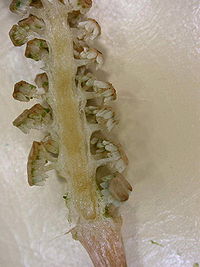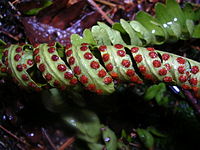
A sporangium (pl., sporangia) is a plant or fungal structure producing and containing spores. Sporangia occur on angiosperms, gymnosperms, ferns, fern allies, mosses, algae, and fungi.
Microsporangia are the structures on the stamens of flowers called anthers, and the pollen-producing structures on the microsporophylls of male conifer cones.
Megasporangia are the comparable "female" structures on these plants, associated with the flower carpel and the megasporangial cone.
On ferns, the mature plant is a sporophyte that develops sporangia, tiny, stalked sacs which contain meiospores, on all or just certain leaves (called sporophylls if sporangia are present).
In mosses, the little case that rises above the vegetative growth on a thin stalk is a sporangium often called a capsule that, as in ferns, produces meiospores. This sporophytic (diploid) growth arises out of the gametophytic (haploid) archegonium after the ovum is fertilized. The sporophyte initially has some chlorophyll, but later turns brown and becomes dependent upon the gametophyte for nutrition, which is absorbed through the foot (base of the stalk), embedded in the archegonial tissues.
Categorized based on developmental sequence, eusporangia and leptosporangia are differentiated in the vascular plants. In a leptosporangium, found only in ferns, development involves a single initial cell that becomes the stalk, wall, and spores within the sporangium. There are around 64 spores in a leptosporangium. In a eusporangium, characteristic of all other vascular plants and some primitive ferns, the initials are in a layer (i.e., more than one). A eusporangium is larger (hence contain more spores), and its wall is multi-layered. Although the wall may be stretched and damaged, resulting in only one cell-layer remaining.
A cluster of sporangia that have become fused in development is called a synangium. This structure is most prominent in Psilotum and Marattiaceae such as Christensenia, Danaea and Marattia.
See also
- archegonium
- antheridium
- For bacteria-related information see endospore

